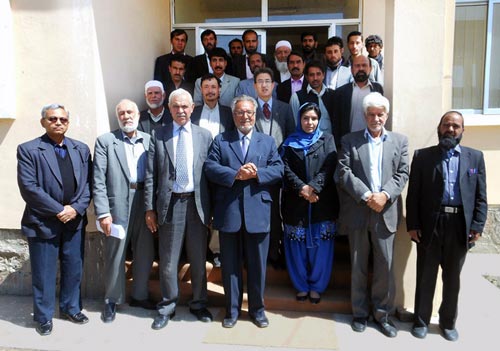 CIMMYT, with support from the Australian Centre for International Agricultural Research (ACIAR), has been working on maize in Afghanistan for more than ten years, and has contributed to the release—led by the Agricultural Research Institute of Afghanistan (ARIA)—of four maize varieties. Historically, the national research and seed systems have not been as proactive for maize as they have for wheat. However, recognizing that maize can be an effective contributor to overall food production, the recent past has seen efforts to give maize its due importance as a food crop in Afghanistan. To this end, the first ARIA-CIMMYT maize workshop was held at the ARIA conference hall in Kabul on 30 April and 01 May 2012, with the aims of further systematizing maize research in the country and coordinating the efforts of stakeholders.
CIMMYT, with support from the Australian Centre for International Agricultural Research (ACIAR), has been working on maize in Afghanistan for more than ten years, and has contributed to the release—led by the Agricultural Research Institute of Afghanistan (ARIA)—of four maize varieties. Historically, the national research and seed systems have not been as proactive for maize as they have for wheat. However, recognizing that maize can be an effective contributor to overall food production, the recent past has seen efforts to give maize its due importance as a food crop in Afghanistan. To this end, the first ARIA-CIMMYT maize workshop was held at the ARIA conference hall in Kabul on 30 April and 01 May 2012, with the aims of further systematizing maize research in the country and coordinating the efforts of stakeholders.
Maize is the fourth most important cereal crop in Afghanistan, accounting for about 6.8% of total cereal production. It has traditionally played a significant role in Afghan food, and during the pre-conflict period Afghanistan grew maize on about half a million hectares, with production reaching 0.7 million tons and productivity at 1.3–1.6 t/ha. During the last decade, productivity has ranged between 0.9 and 2.6 t/ha with signs of improvement, but the area planted to maize has fallen to about 180,000 hectares and total production has hovered around 0.3 million tones. The country has been importing maize to meet its needs, spending about four million USD during 2009.
The workshop was inaugurated by Sahib Dad Pakbin, senior advisor to ARIA. He welcomed the CIMMYT initiative and said he hoped the workshop would lead to increased coordination and more effective contributions by maize researchers in the country. Rajiv Sharma, CIMMYT’s country liaison officer for Afghanistan, highlighted the important supplementary role maize could play in enhancing wheat-based farm-level productivity. A total of 28 participants attended and gave presentations at the workshop, from ARIA, CIMMYT, the Afghan Ministry of Agriculture, Irrigation and Livestock (MAIL), FAO, the International Center for Agricultural Research in the Dry Areas (ICARDA), and private sector seed companies. The themes covered included the importance of maize in Afghanistan, maize agronomy, maize breeding, seed production, and the maize research network in Afghanistan.
All the participants were excited by the opportunity to collaborate with fellow researchers, in particular the ARIA maize researchers by the chance to connect with colleagues from other research stations. They expressed immense satisfaction at being able to share and link their proposed research plans for the ensuing maize season. ARIA director Qasem Obaidi thanked CIMMYT for its contributions in providing this opportunity and expressed the wish that it would be repeated in years to come to facilitate meaningful coordination, not only among researchers but also other stakeholders such as seed producers.

